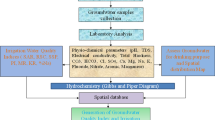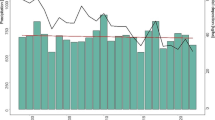Abstract
Water conservation is critical because it is one of the most significant factors for all species' survival. According to the Central Ground Water Board's estimates, underground water will be scarce in 15 Indian states by 2025 (Firstpost. Two-third of the world, much of India to face water scarcity, stress by 2025: Expert, 2018). However, as per the report from Ministry of Environment and Forest, only 10 to 20% rainwater is harvested. In urban areas, it is seen that nowadays concrete structures are constructed everywhere, so it is not possible to recharge the water table by natural process of raining. All the rainwater which is one of the sources for fresh water goes to drain. This causes the depletion of groundwater level which may be fatal in the future. Therefore, a rainwater harvesting system is required in Indian household to conserve water. On the other hand, the urban cities are having high pollutant levels which in turn affecting the quality of water. The government has defined certain parameters for quality checking of water. With the aid of the suitable sensors and IoT boards, quality checking, monitoring and water segregation can be easily achieved. In this work, an efficient and cost effective technique of rainwater harvesting has been presented. Some real case studies have been done at Indian houses in order to validate the effectiveness of system in terms of its implementation and cost analysis. As a result, the proposed system becomes one of the smart solutions to address the modern problem of rainwater harvesting with water quality management in low cost.








Similar content being viewed by others
Data Availability
Not applicable.
Code Availability
All the experiments have been performed using open source software Arduino Sketch and no exact code has been copied for research paper.
References
Firstpost. Two-third of the world, much of India to face water scarcity, stress by 2025: Expert. https://www.firstpost.com/tech/science/two-third-of-the-world-much-of-india-to-face-water-scarcity-stress-by-2025-expert-5675721.html Accessed 05 December 2018.
Gautam, A., Verma, G., Qamar, S., & Sushant, S. (2021). Vehicle pollution monitoring, control and challan system using MQ2 sensor based on Internet of Things. Wireless Personal Communications, 116, 1071–1085.
Pule, M., Yahya, A., & Chuma, J. (2017). Wireless sensor network: A survey on monitoring water quality. Journal Applied Research and Technology, 15(6), 562–570.
Vinoj, J., & Gavaskar, S. (2018). Smart city rainwater harvesting technique. International Journal of Scientific Development and Research, 3(8), 1–6.
Bin, M. A., & Abidin, M. Z. (2016). Water quality assessment of rainwater collected from rooftop at UTM (pp. 86–93). Proceedings of Faculty of Civil Engineering.
Dehua, W., Pan, L., Bo, L. U., & Zeng, G. (2012). Water quality automatic monitoring system based on GPRS data communication. Proceedings of International Conference on Modern Hydraulic Engineering, 28, 840–843.
Louis, G., & Kumar, A. S. (2016). The red rain phenomenon of Kerala and its possible extra-terrestrial origin. Astrophysics and Space Science, 302(1), 175–187.
Liang, R., Di Matteo, M., Maier, H. R., & Thyer, M. A. (2019). Real-time smart rainwater storage systems: potential solution to mitigate urban flooding. Water, 11, 2428.
Oberascher, M., Zischg, J., Kastlunger, U., Schöpf, M., Kinzel, C., Zingerle, C., Rauch, W., & Sitzenfrei, R. (2019). Advanced rainwater harvesting through smart rain barrels. In V. A. Reston (Ed.), World environmental and water resources congress (pp. 75–82). American Society of Civil Engineers.
Asadi, S. S., Kumar, N. V., Rajyalakshmi, K., & Kumar, M. S. (2017). “Designing of water harvesting structures for water resources management: A model study from Chelila watershed, Bhutan. International Journal of Mechanical Engineering and Technology, 8(10), 666–679.
Yazar, A., & Ali, A. (2016). Water harvesting in dry environments. In M. Farooq & K. Siddique (Eds.), Innovations in dryland agriculture. Springer.
Larrison, J. (2017) Automated Rainwater Collection System Controller. US Patent 9,633,532 B1.
Nigel, O. (2009) Rain Water Harvesting System. England Patent WO 2009/133405 Al.
Borthakur, S. (2009). Traditional rain water harvesting techniques and its applicability. Indian Journal of Traditional Knowledge, 8(4), 525–530.
Bhattacharya, S. (2015). Traditional water harvesting structures and sustainable water management in India: A socio-hydrological review. International Letters of Natural Sciences, 37, 30–38.
Dusarlapudi, K., Chandrika, V. S. P., Kota, C. R., Annepu, M., & Narayana, V. (2020). Accuracy analysis of an ultrasonic sensor over an open channel rectangular notch for rainwater harvesting. International Journal of Scientific & Technology Research, 9(1), 2813–2816.
Chandrika, V. S. P., Kota, C. R., Annepu, K. D., Sreelatha, E., & Tiruvuri, C. S. (2020). Smart approach of harvesting rainwater and monitoring using IoT. Journal of Advanced Research in Dynamical & Control Systems, 12(2), 91–100.
Rahul, H. K., Rakesh, M., Manjula, R. B., Rakesh, C. G., & Rahul, R. (2020). Rain Water harvesting and smart farming using IoT. International Research Journal of Engineering and Technology, 7(5), 1330–1339.
Ranjan, V., Reddy, M. V., Irshad M., Joshi, N. (2020). The Internet of Things (IOT) based smart rain water harvesting system. Proceedings of 2020 6th International Conference on Signal Processing and Communication (ICSC), Noida, India, pp. 302–305.
Verma, G., Gupta S., Gupta, R. (2020). IoT based technique for household rainwater harvesting. Proceedings of 2020 Global Conference on Wireless and Optical Technologies (GCWOT), Malaga, Spain, pp. 1–4.
Funding
Not applicable.
Author information
Authors and Affiliations
Corresponding author
Ethics declarations
Conflict of Interest
The author declares no conflict of interest regarding the publication of this research paper.
Additional information
Publisher's Note
Springer Nature remains neutral with regard to jurisdictional claims in published maps and institutional affiliations.
Rights and permissions
Springer Nature or its licensor holds exclusive rights to this article under a publishing agreement with the author(s) or other rightsholder(s); author self-archiving of the accepted manuscript version of this article is solely governed by the terms of such publishing agreement and applicable law.
About this article
Cite this article
Verma, G. Low Cost Smart Ground System for Rainwater Harvesting for Indian Houses using IoT Technology. Wireless Pers Commun 126, 3317–3332 (2022). https://doi.org/10.1007/s11277-022-09866-w
Accepted:
Published:
Issue Date:
DOI: https://doi.org/10.1007/s11277-022-09866-w




